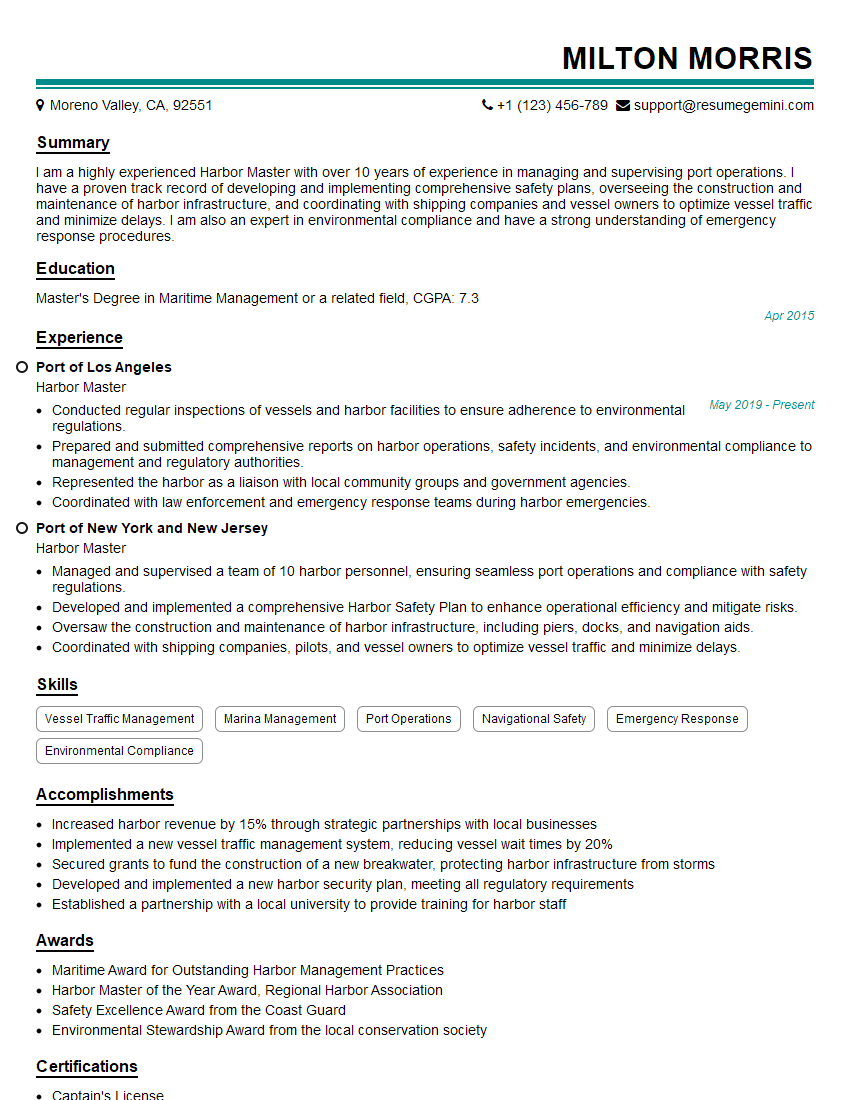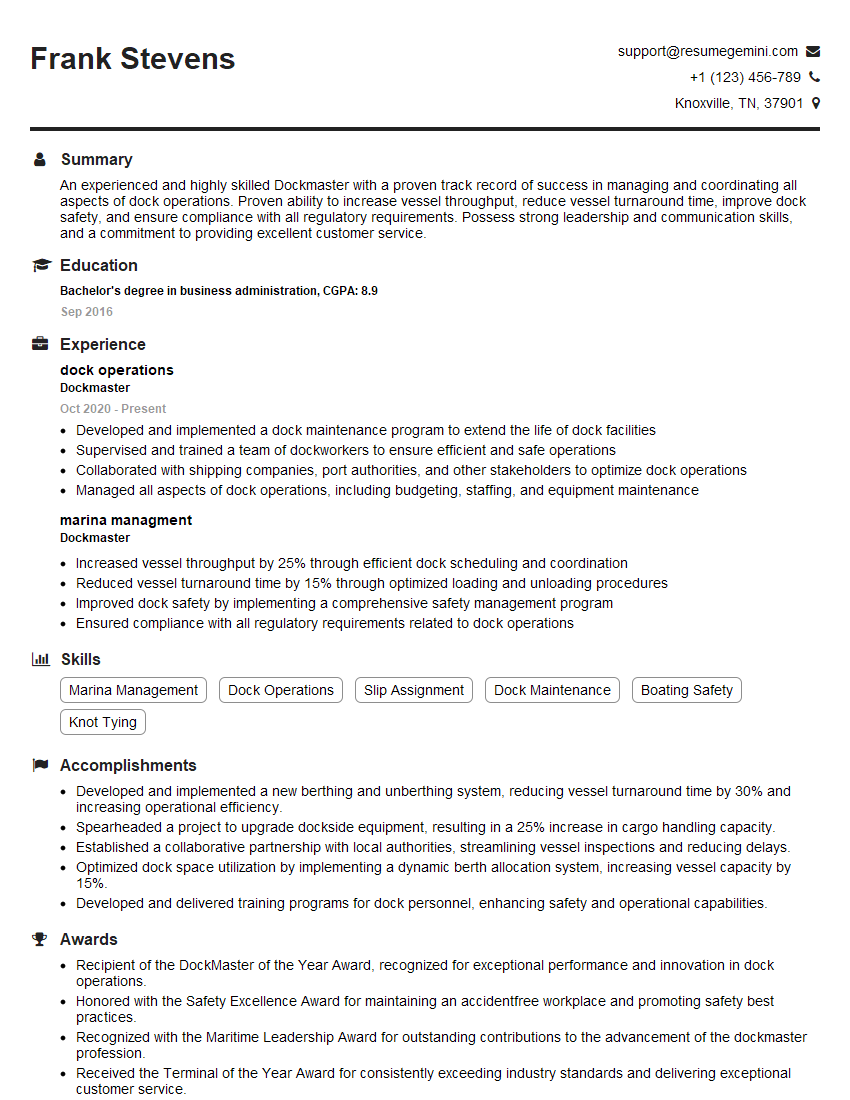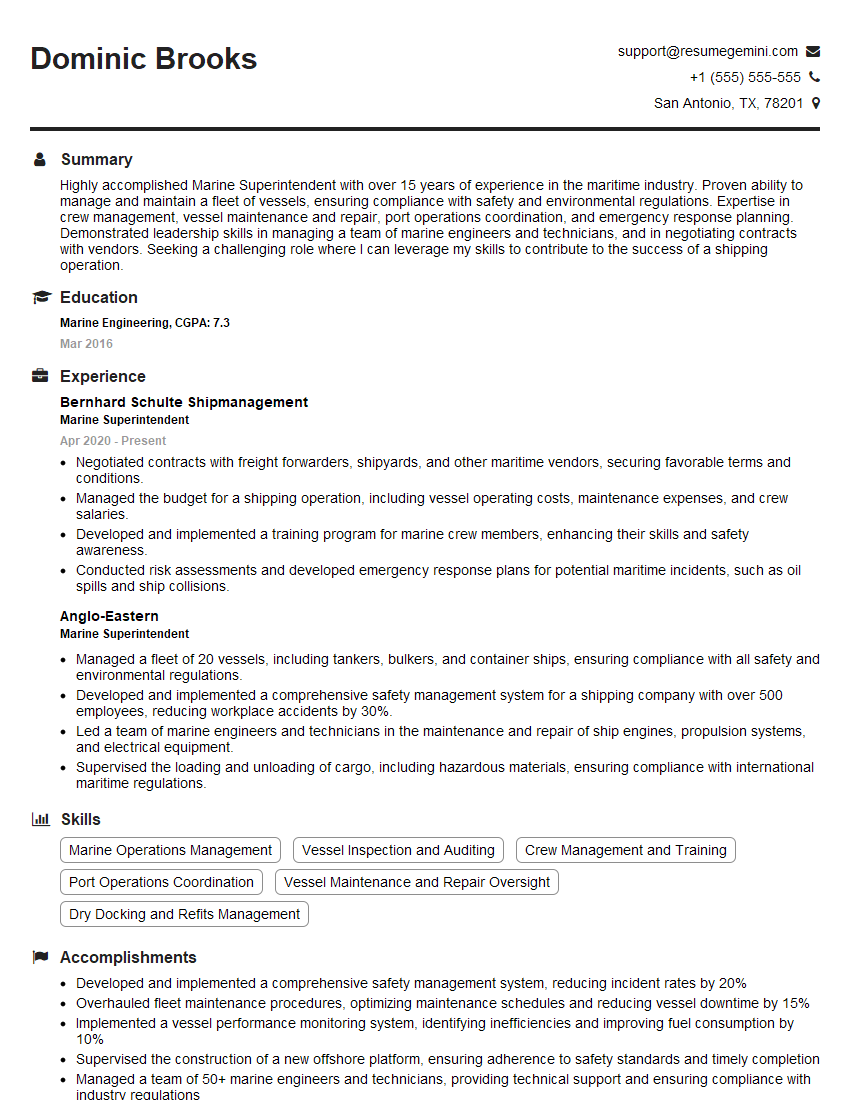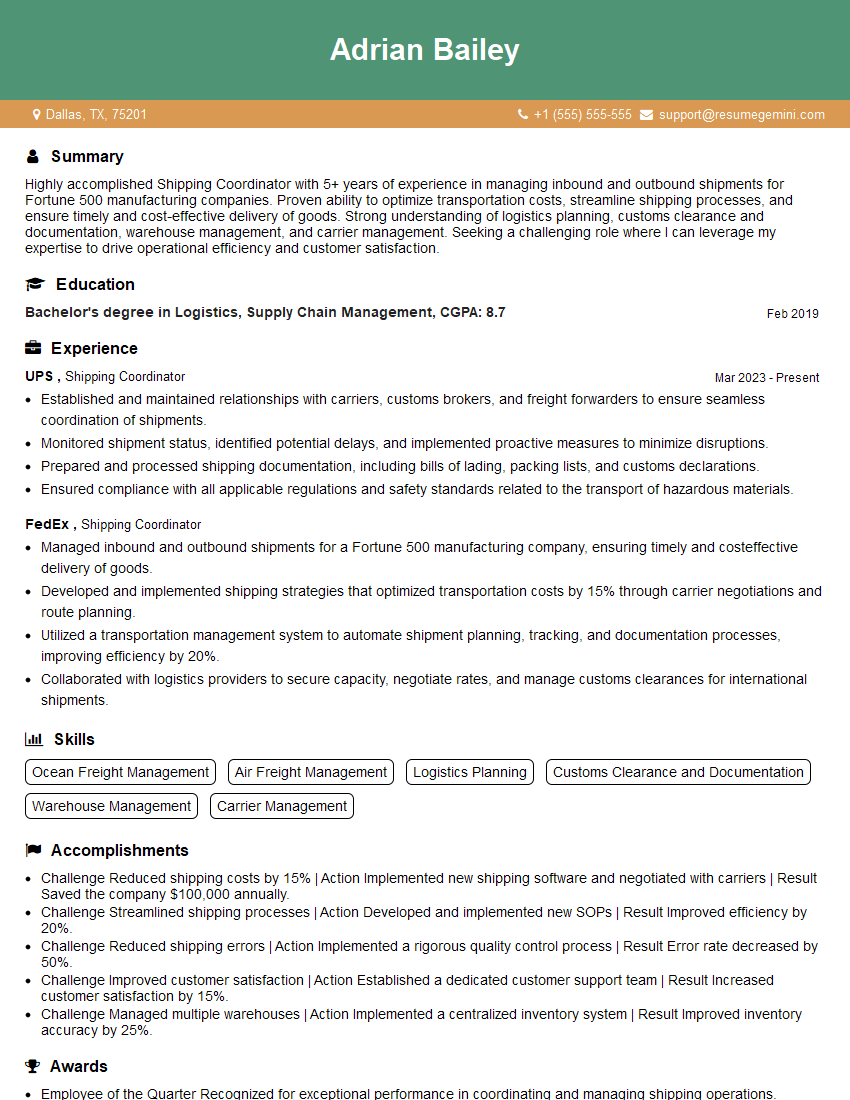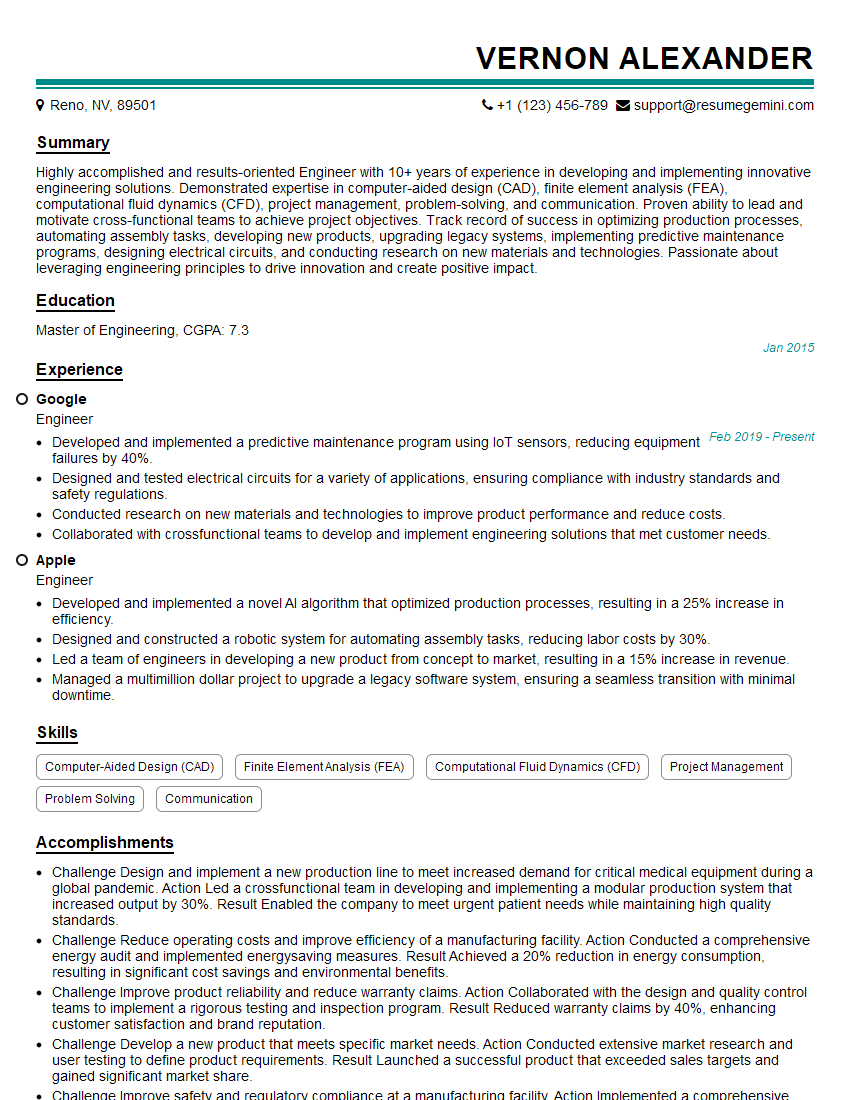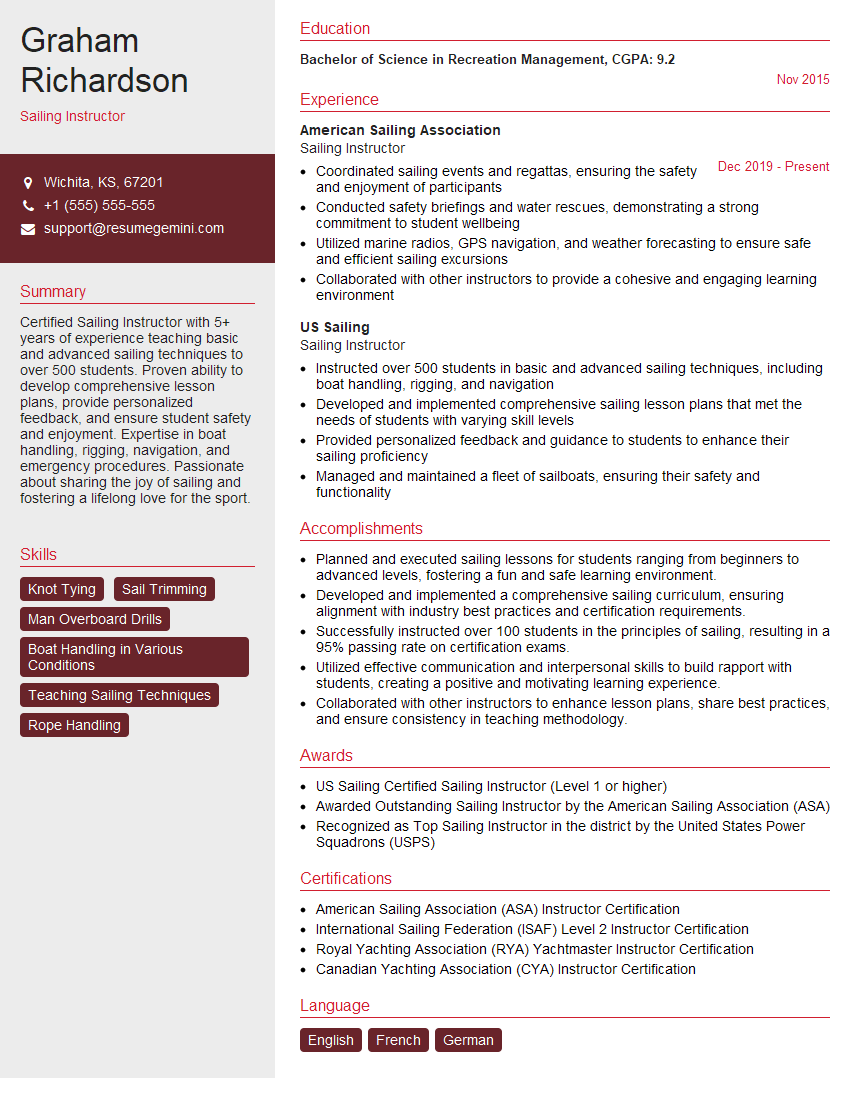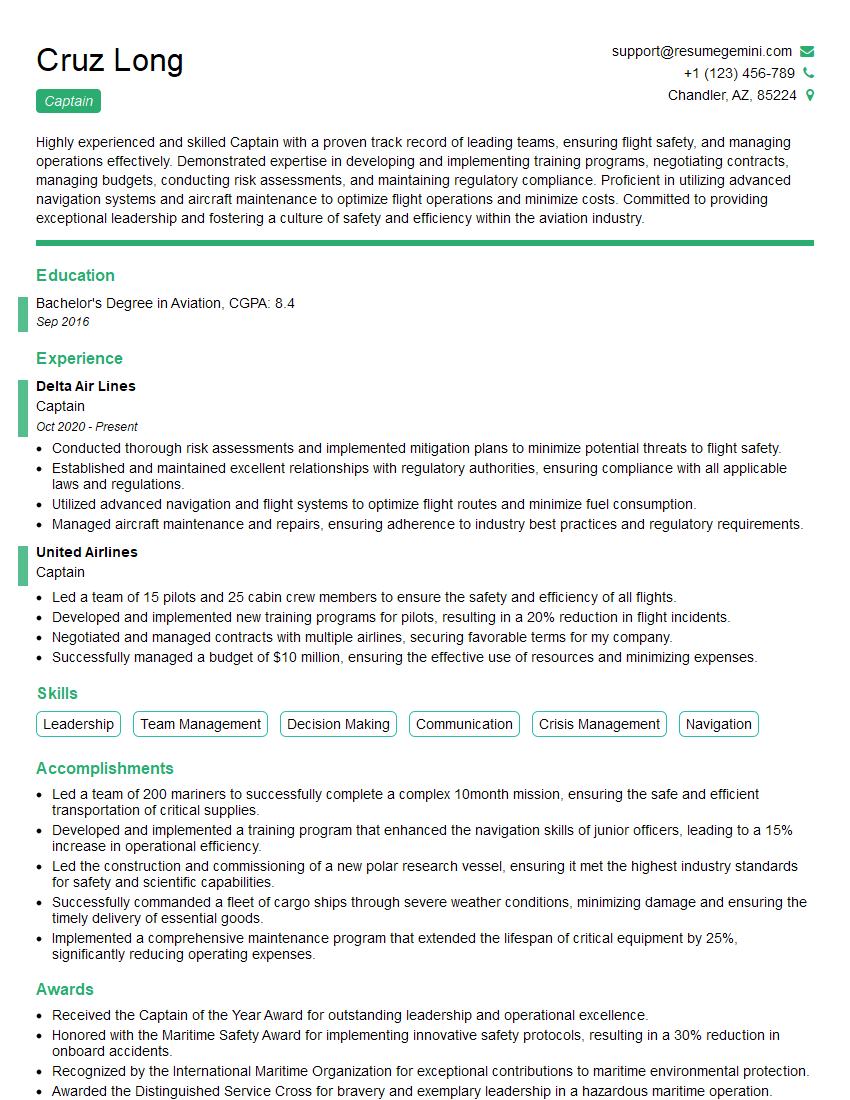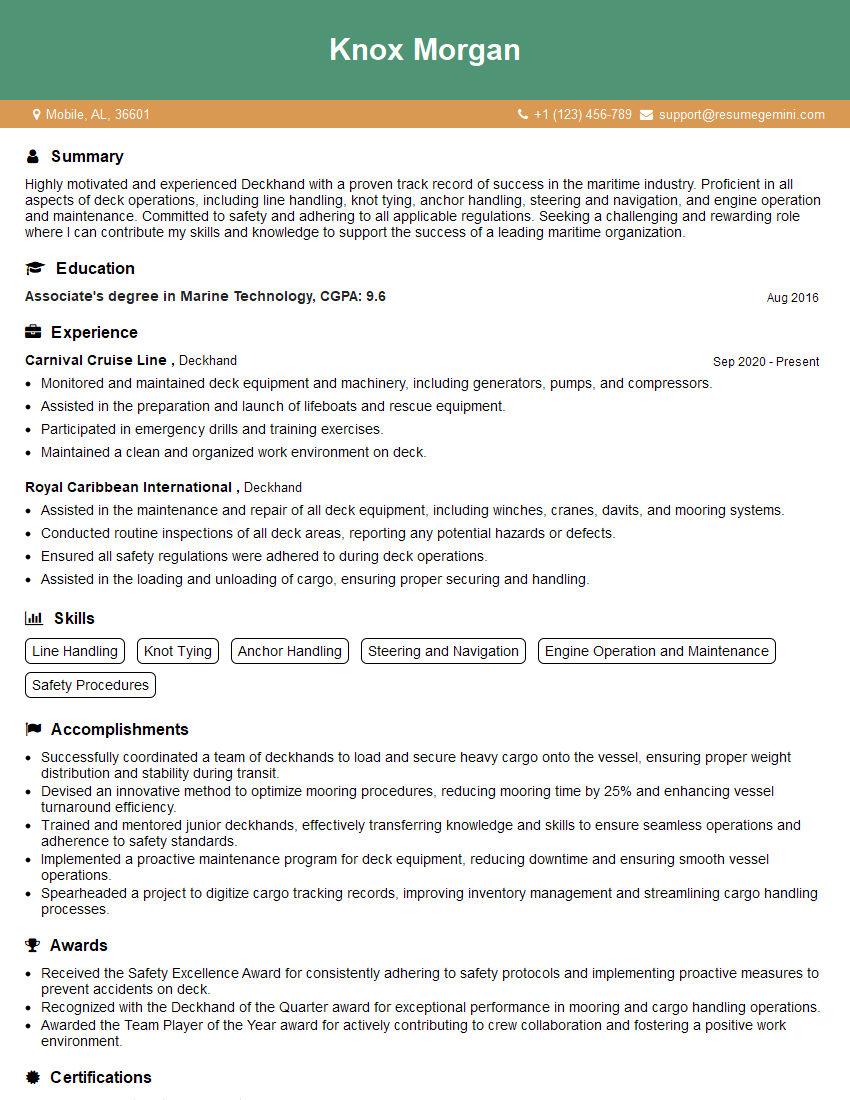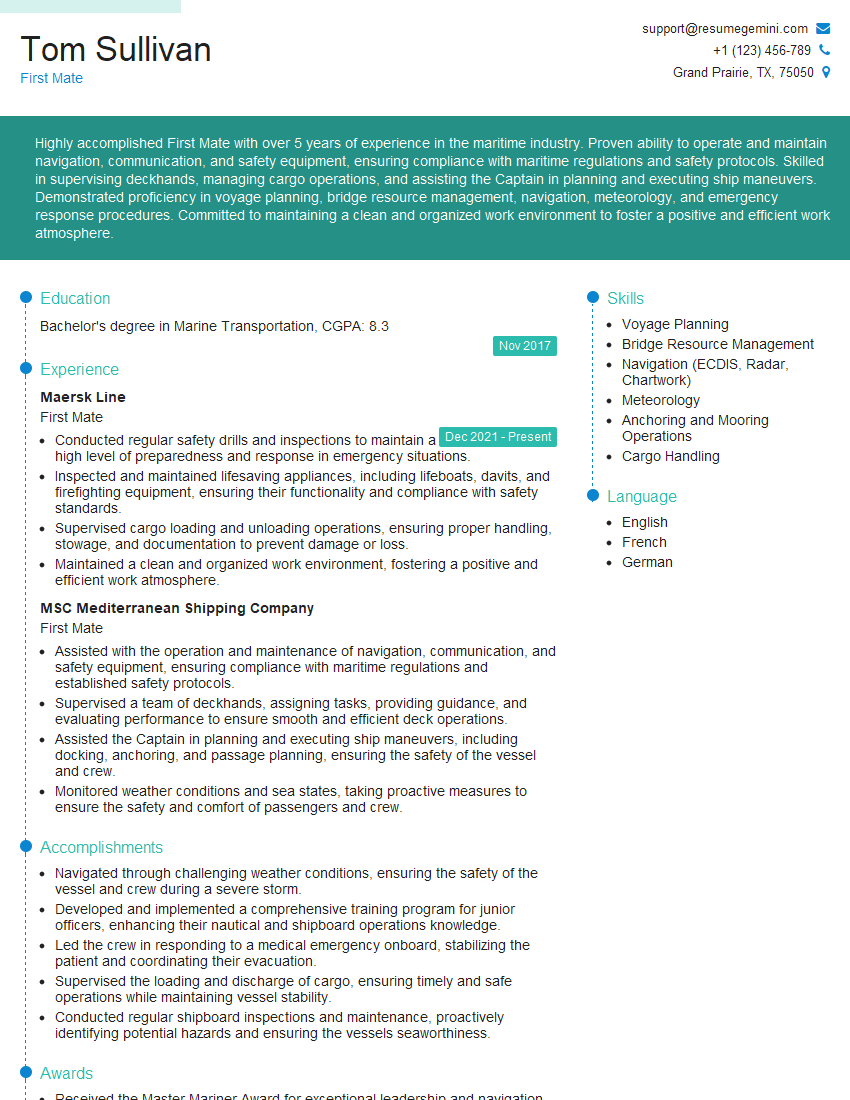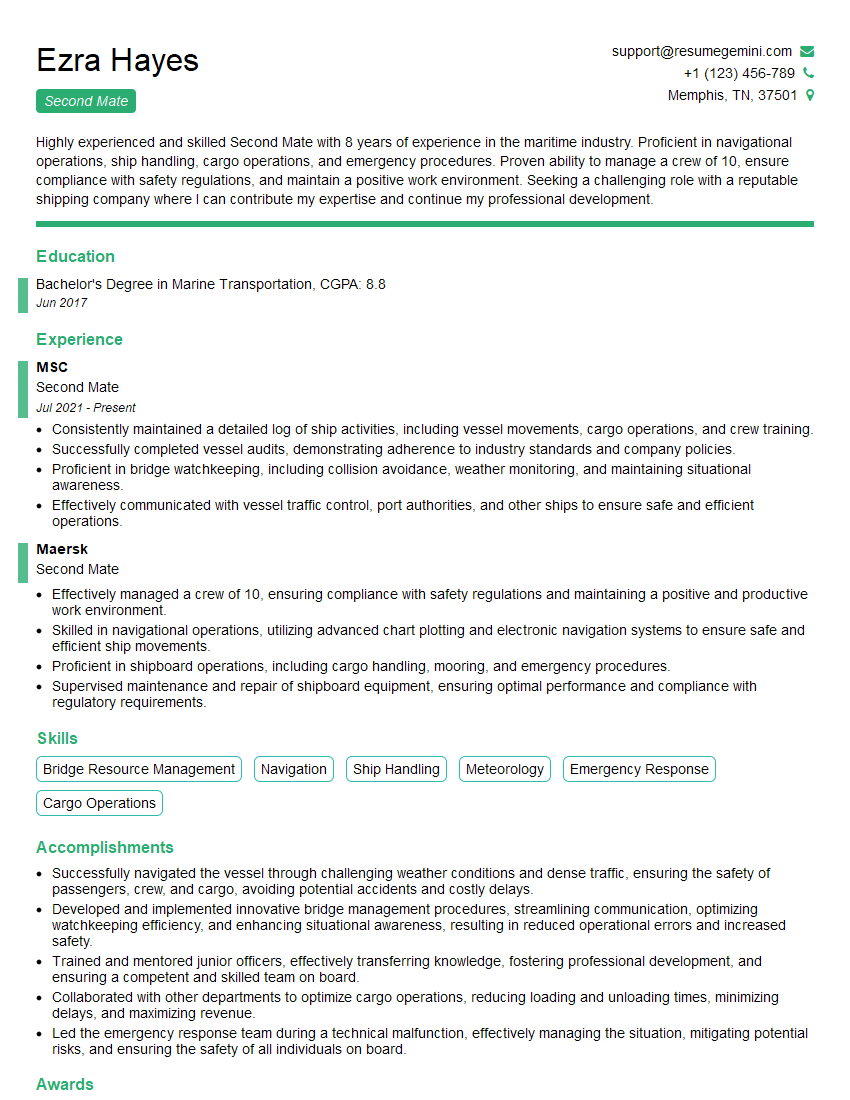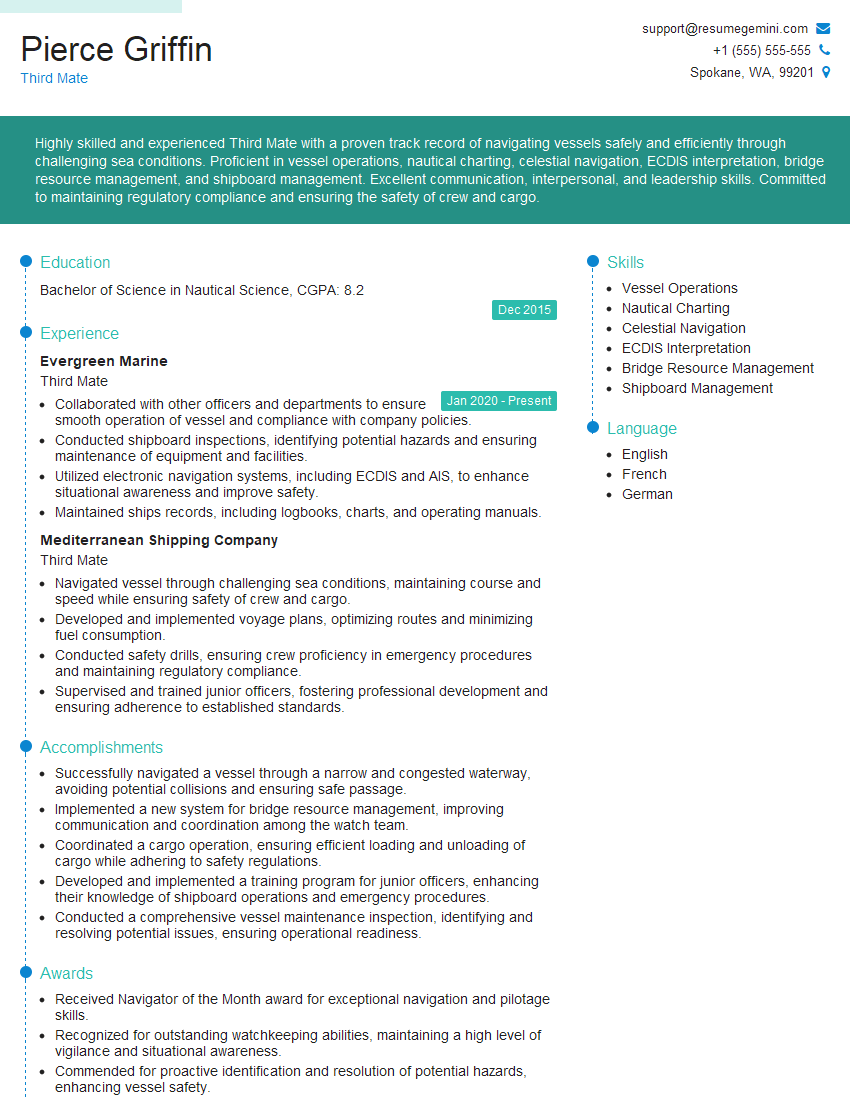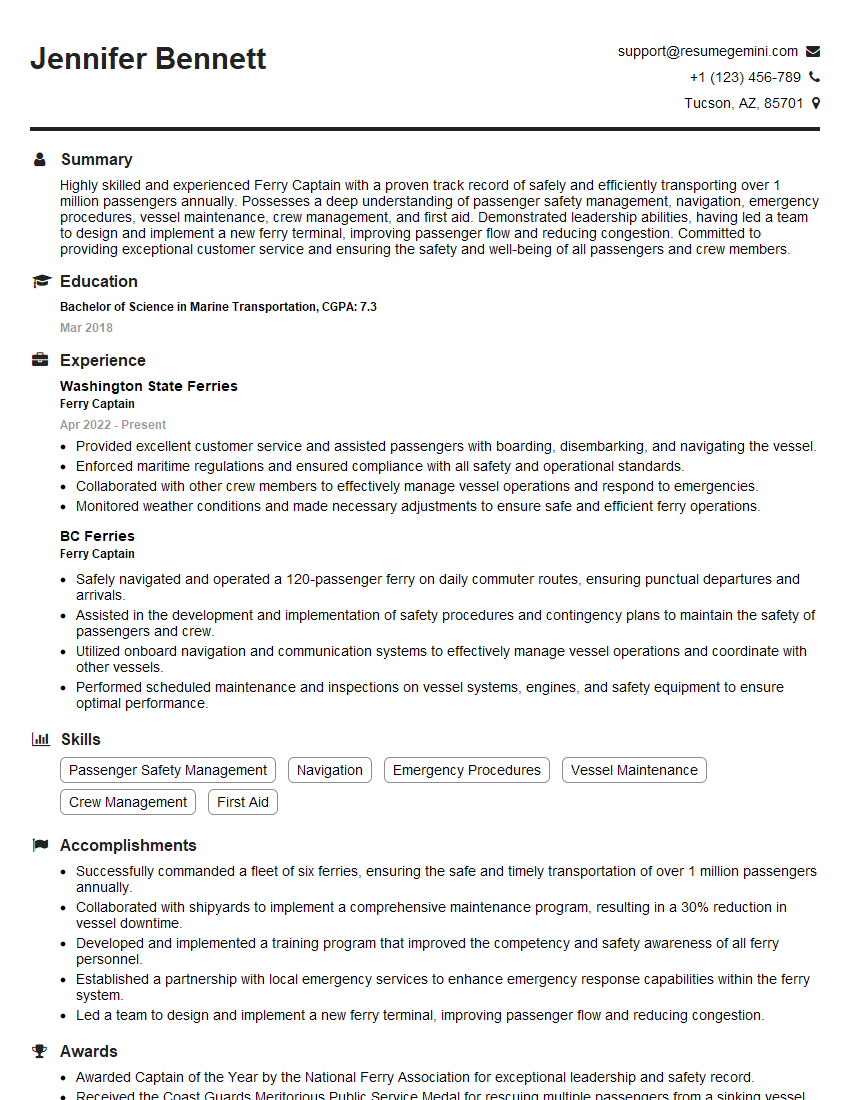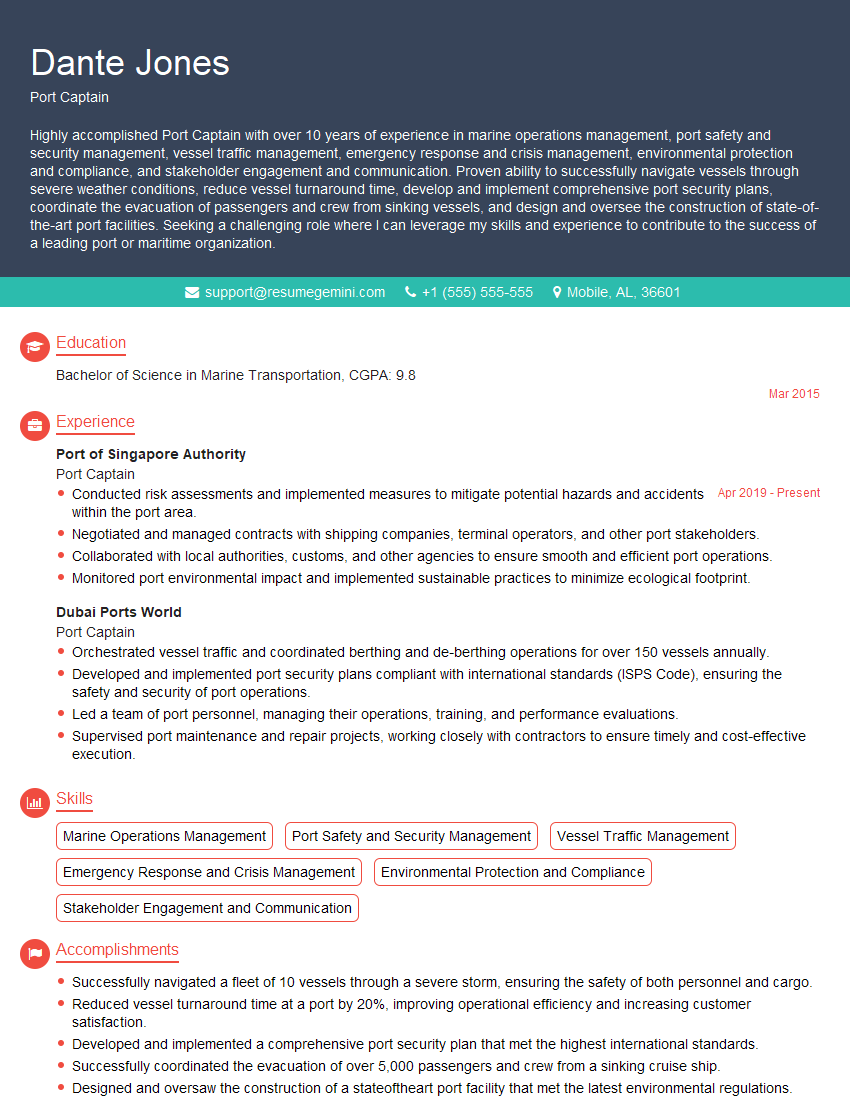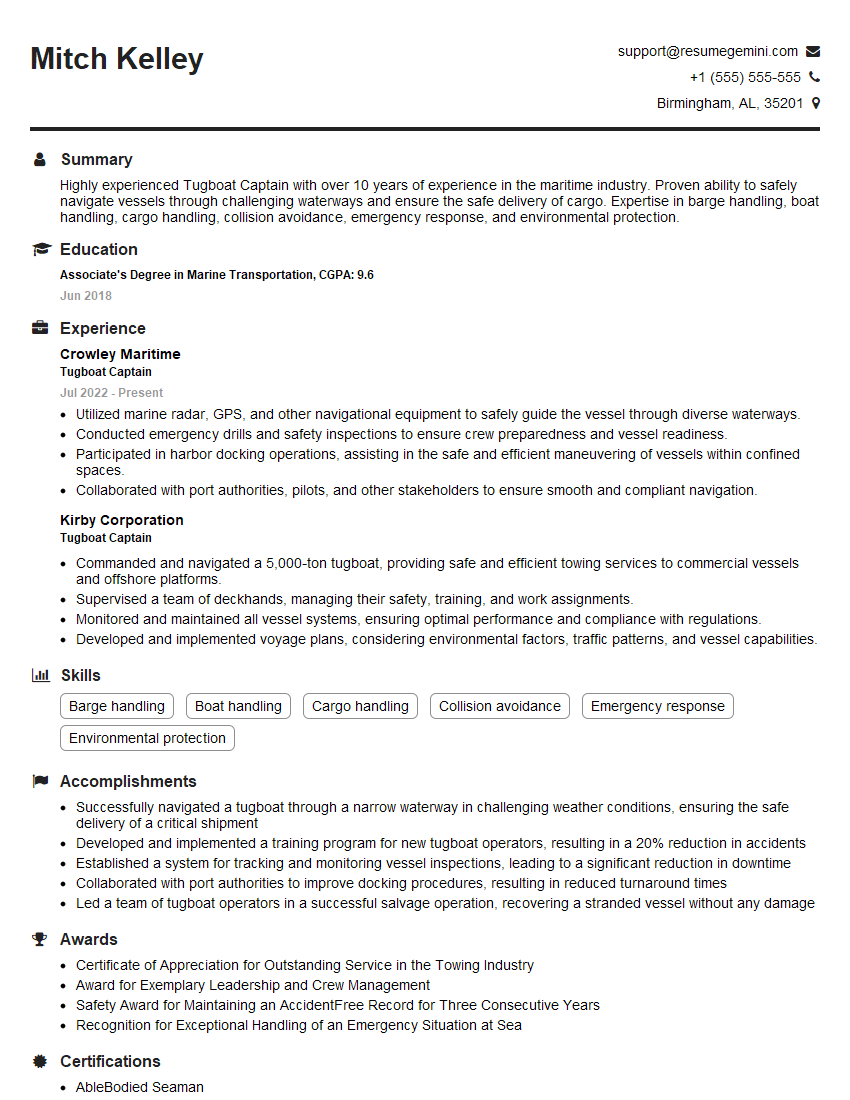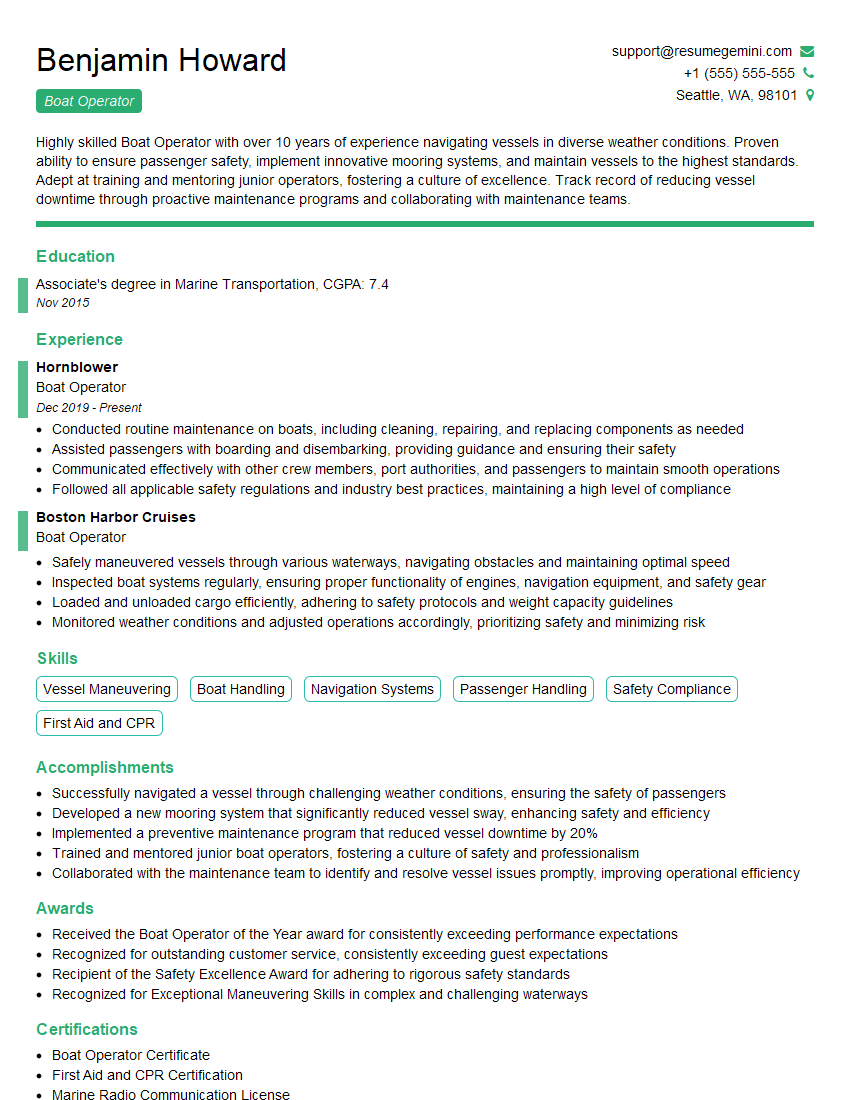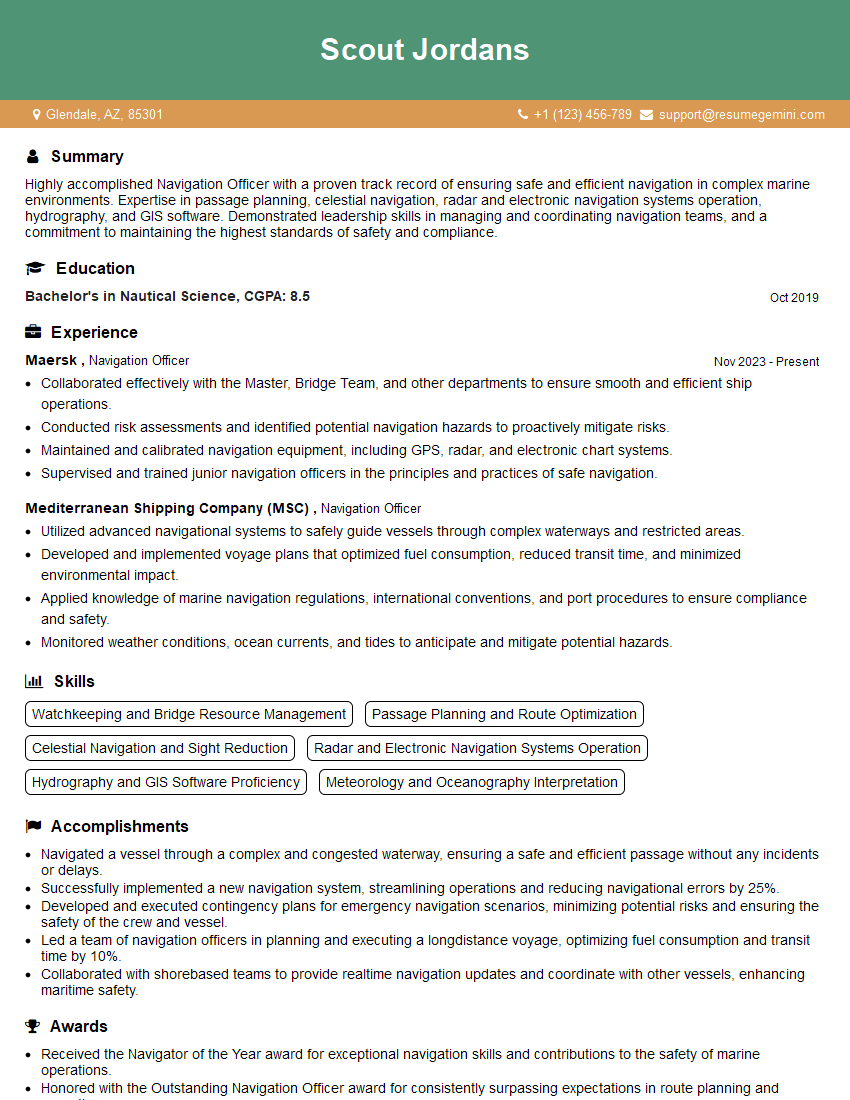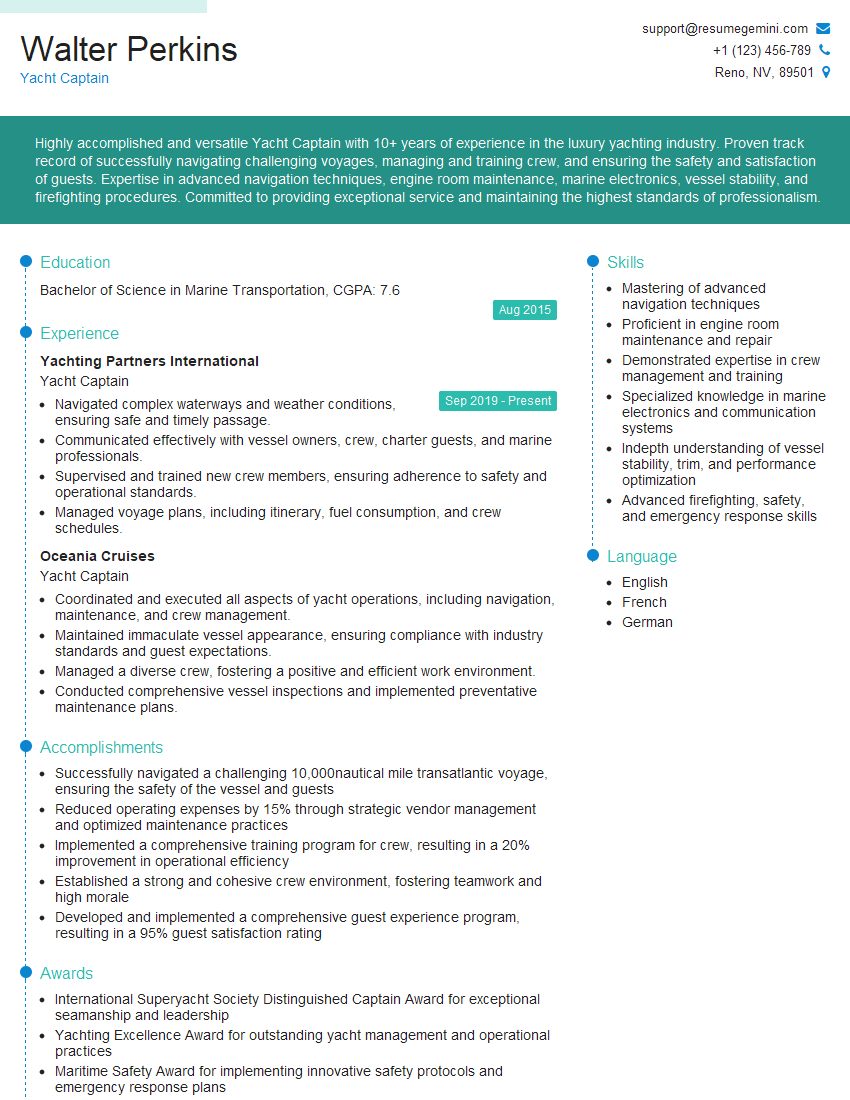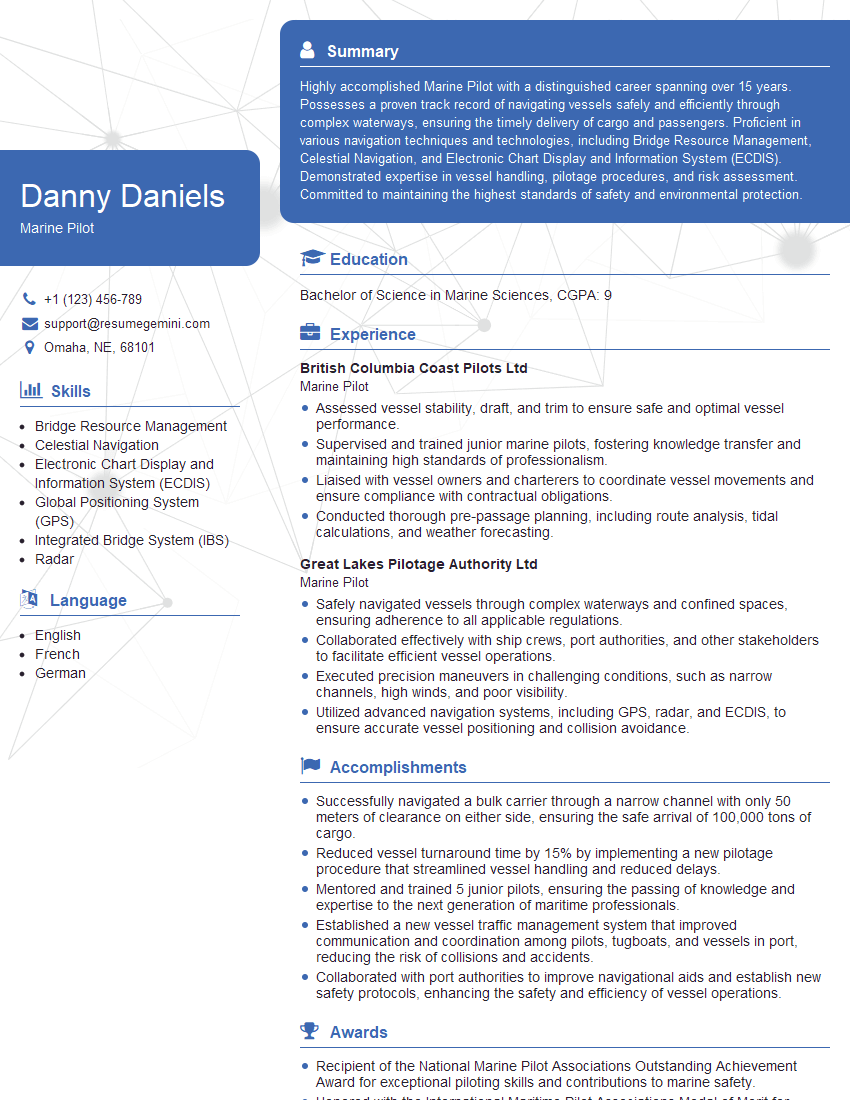Feeling uncertain about what to expect in your upcoming interview? We’ve got you covered! This blog highlights the most important Working with other boat operators interview questions and provides actionable advice to help you stand out as the ideal candidate. Let’s pave the way for your success.
Questions Asked in Working with other boat operators Interview
Q 1. Describe your experience working as part of a boat crew.
My experience working as part of a boat crew spans over eight years, encompassing roles from deckhand to second mate on various vessel types, including fishing trawlers, passenger ferries, and research vessels. I’ve consistently worked effectively within teams of diverse backgrounds and skill levels, prioritizing teamwork and shared responsibility for the safety and efficiency of operations. For example, during my time on a fishing trawler, coordinating the hauling of nets required precise timing and communication amongst the entire crew, highlighting the importance of clear instructions and collaborative effort under pressure. On a passenger ferry, maintaining a clean and safe environment for passengers while adhering to strict safety protocols involved seamless collaboration with the other crew members. This experience instilled in me the importance of clear communication, mutual respect, and efficient delegation of tasks.
Q 2. Explain your understanding of maritime communication protocols.
Maritime communication protocols are crucial for safe and efficient operations at sea. They encompass visual, sound, and radio communication methods, all governed by international regulations like the International Code of Signals (ICS) and the Collision Regulations (COLREGs). Understanding and adhering to these protocols is paramount to avoid collisions, misunderstandings, and emergencies. Visual signals, such as flags and lights, communicate vessel intentions and status. Sound signals, like foghorns and whistles, provide warnings and identification in reduced visibility. Radio communication, using VHF radios and GMDSS systems, allows for real-time communication with other vessels, coast guard, and port authorities. I’m proficient in using all these methods, understanding the importance of precise terminology, clear articulation, and confirming receipt of messages. For instance, I regularly use the standard phraseology like “Mayday” for distress calls, “Pan Pan” for urgent situations and utilize VHF radio for regular communication with harbor masters and other vessels, especially in congested waterways.
Q 3. How do you handle conflicts with other crew members?
Conflicts within a crew are inevitable, but effective conflict resolution is essential for maintaining a positive and productive work environment. My approach prioritizes open and respectful communication. I focus on understanding each individual’s perspective, actively listening to their concerns, and calmly expressing my own viewpoint. I aim to find common ground and collaboratively develop solutions that address the root causes of the conflict. For example, if a disagreement arises about workload distribution, I would facilitate a discussion to identify the tasks that are causing the bottleneck and create a fair allocation based on individual skills and experience. I believe in promoting a culture of mutual respect and understanding, where team members feel comfortable raising concerns without fear of retribution.
Q 4. What safety procedures do you follow when working with other boat operators?
Safety procedures when working with other boat operators are paramount. This begins with adhering to COLREGs, ensuring proper lookout and maintaining safe distances from other vessels. Regular safety briefings before commencing any operation are vital to ensure everyone understands the plan, potential hazards, and emergency procedures. Communication with other vessels, using proper radio protocols, is essential for coordinating maneuvers and avoiding potential collisions. Carrying and knowing how to use appropriate personal protective equipment (PPE) and safety equipment, such as life jackets and flares, is non-negotiable. Further, regular maintenance and inspection of all equipment contribute heavily to safety. For instance, ensuring the operability of our boat’s radio and navigation systems is a crucial aspect of our pre-trip checklist. Moreover, always ensuring clear communication during any transfer of supplies or personnel from one vessel to another is critical.
Q 5. Describe a time you had to make a quick decision to ensure the safety of the crew.
During a sudden squall while transporting cargo between two vessels, the unsecured load started shifting dangerously. I immediately assessed the situation, ordered the crew to take cover, and directed the crane operator to secure the load as quickly as possible. This swift action prevented a potentially disastrous situation where cargo could have fallen overboard, causing damage to the vessels and potential injury to the crew. This experience taught me the importance of rapid assessment, decisive action, and clear communication under stressful conditions. Prioritizing the safety of the crew always comes first.
Q 6. How do you ensure clear communication in challenging weather conditions?
Maintaining clear communication in challenging weather conditions requires redundant communication methods and robust procedures. While VHF radio is the primary method, using hand signals and visual aids, such as flares, becomes essential if radio communication fails. Prior to setting sail, ensuring all team members understand and have practiced communication protocols in challenging conditions is crucial. Simple, clear, and repeated messages ensure everyone understands. For instance, using standard phrases and emphasizing critical instructions are paramount. Pre-arranged hand signals might replace verbal communications during storms, greatly simplifying the communication and avoiding misunderstandings.
Q 7. How do you manage workload distribution amongst crew members?
Workload distribution requires careful planning and consideration of individual skills and limitations. Before any operation, I work with the crew to assign tasks based on expertise and experience. Regular checks are conducted to ensure everyone is managing their workload effectively. Open communication is encouraged to identify bottlenecks or imbalances. If one member is struggling, we re-allocate tasks to maintain balance. For example, on a longer voyage, tasks are rotated to avoid fatigue and maintain crew morale. Fairness and recognizing each crew members’ contributions is key to ensuring a productive and well-functioning team.
Q 8. Explain your experience with navigation equipment and its use in coordination with other vessels.
My experience with navigation equipment is extensive, encompassing both traditional and modern systems. I’m proficient in using GPS chartplotters, radar, AIS (Automatic Identification System), and electronic charting systems (ECS) like those from Navionics or C-MAP. In coordinating with other vessels, this expertise is crucial. For example, using AIS, I can see the position, course, and speed of nearby vessels, allowing me to anticipate their movements and adjust my own course to maintain safe distances and avoid potential collisions. Radar provides situational awareness in low visibility, and I regularly use it in conjunction with GPS to navigate safely through congested waterways or during adverse weather conditions. Sharing relevant data from these systems via VHF radio, particularly position reports and intentions, improves coordination and communication with other vessels, especially in complex situations like approaching a narrow channel or during search and rescue operations.
For instance, during a recent transatlantic voyage, we used our AIS to track the position of a much larger container ship. By monitoring its course and speed, we could adjust our course accordingly to ensure a safe passing distance. This prevented any risk of collision while allowing both vessels to proceed efficiently on their respective routes.
Q 9. Describe your knowledge of the International Regulations for Preventing Collisions at Sea (COLREGs).
The International Regulations for Preventing Collisions at Sea (COLREGs) are the cornerstone of safe navigation. My understanding of COLREGs is comprehensive, covering all aspects from rules of the road to lights and shapes signaling a vessel’s status and intentions. I’m very familiar with the rules of precedence—giving way versus standing-on—understanding how to determine which vessel has the right of way in various situations, such as crossing, overtaking, and head-on situations. I can also apply the COLREGs in various visibility conditions, including fog, and understand how to use sound signals effectively.
Beyond simply knowing the rules, I emphasize practical application. I’ve applied COLREGs countless times in navigating busy harbors, narrow channels, and during transits at night, using effective communication to signal my intentions to nearby vessels and to confirm mutual understanding of the situation. I constantly review and update my knowledge of COLREGs to ensure I’m up-to-date with any changes or interpretations. Understanding COLREGs isn’t just about avoiding collisions; it’s about fostering a culture of mutual respect and responsibility on the water.
Q 10. How do you contribute to a positive and productive team environment on board?
Contributing to a positive and productive team environment involves open communication, mutual respect, and shared responsibility. I believe in clear and concise instructions, fostering teamwork through collaboration and shared decision-making. I actively listen to my crew members’ concerns and suggestions, ensuring everyone feels heard and valued. I also prioritize safety and maintain a calm and professional demeanor, even in stressful situations. I lead by example, demonstrating diligence and commitment to our shared goals. I encourage problem-solving through open discussion, ensuring everyone understands the tasks and their importance within the overall objective.
During a challenging voyage through rough seas, for example, I ensured all crew members were aware of the situation and their specific roles in managing the vessel. By maintaining open communication and clearly assigning tasks, we were able to navigate the difficult conditions safely and effectively.
Q 11. What is your experience with emergency procedures at sea and coordinating with other vessels?
My experience with emergency procedures at sea is extensive and includes participation in numerous drills and real-world scenarios. I’m adept at handling various emergencies such as man overboard, fire, flooding, and medical emergencies. My training encompasses the use of emergency equipment like life rafts, EPIRBs (Emergency Position-Indicating Radio Beacons), and fire extinguishers. Coordinating with other vessels during emergencies requires clear and concise communication via VHF radio. This involves providing accurate position reports, describing the nature of the emergency, and requesting assistance, following standardized emergency procedures.
In one instance, we successfully coordinated a rescue operation with a nearby fishing vessel after a crew member suffered a serious injury. Our prompt and efficient communication ensured the injured crew member received timely medical attention. The successful outcome underscored the importance of clear communication and coordination.
Q 12. Describe your proficiency in using nautical charts and electronic navigation systems.
I am highly proficient in using both nautical charts (paper and electronic) and electronic navigation systems (ENS). I can accurately plot courses, determine positions, and calculate estimated times of arrival (ETAs) using both methods. I understand chart symbols, abbreviations, and depth soundings, and I can interpret tide and current information to safely navigate various waterways. My ENS skills encompass the use of GPS, radar, and AIS to accurately determine position, monitor other vessels, and avoid hazards. I am also experienced in using electronic charting systems (ECS) to plan voyages, monitor vessel performance, and manage waypoints.
For example, when navigating a particularly complex area with numerous shallows and submerged obstructions, I relied on both paper charts and my ECS to confirm the depth readings and ensure we maintained a safe distance from any hazards. This combination of traditional and modern navigational tools allows for a higher level of accuracy and redundancy, minimizing risk.
Q 13. How do you handle situations where another vessel is operating unsafely?
When encountering a vessel operating unsafely, my priority is ensuring the safety of my vessel and crew. This involves maintaining a safe distance, carefully monitoring the other vessel’s actions, and using VHF radio to politely and professionally communicate my concerns. I might use phrases such as, “This is [Vessel Name], I am concerned about your close proximity to the navigation markers.” or “This is [Vessel Name], requesting you alter course to avoid a potential collision.” I will also document the incident, noting the time, location, vessel characteristics, and unsafe behaviors observed. If the unsafe behavior persists or poses an imminent threat, I will consider contacting the relevant authorities, such as the Coast Guard.
The goal isn’t confrontation but rather to communicate risks constructively and proactively seek safe solutions. Prioritizing safety and professional communication is always paramount.
Q 14. How would you address a situation where a crew member is not following safety protocols?
Addressing a crew member who is not following safety protocols begins with a private and direct conversation. I start by calmly explaining the importance of the safety protocol in question and how the crew member’s actions compromised safety. I listen to their perspective and attempt to understand the reasons for their actions. This approach avoids confrontation while emphasizing the importance of compliance. Depending on the severity of the infraction, further action may be necessary, ranging from retraining to disciplinary measures in accordance with company policy. Consistency in reinforcing safety procedures and addressing non-compliance prevents accidents and reinforces a culture of safety.
For instance, if a crew member was not wearing their personal floatation device (PFD) while on deck, I’d address the issue promptly and privately, explaining the potential consequences. Retraining might be necessary to ensure full understanding of the safety requirements, and I would follow-up to ensure compliance.
Q 15. Describe your experience with vessel maintenance and its importance for teamwork.
Vessel maintenance is paramount for safe and efficient operations, and it directly impacts teamwork. A well-maintained vessel operates smoothly, minimizing breakdowns and delays, which reduces stress and friction among crew members. My experience encompasses preventative maintenance schedules, troubleshooting mechanical issues, and conducting regular safety checks. For example, ensuring the engine room is clean and organized prevents accidents and allows for easier access during emergencies. This proactive approach fosters a collaborative environment, where everyone understands their role in maintaining the vessel’s readiness.
In my previous role, we implemented a daily checklist for engine checks and weekly inspections of safety equipment. This system reduced downtime by 30%, creating a more positive and productive atmosphere on board. Effective teamwork requires shared responsibility for maintenance; each crew member understands their individual contribution to the overall health of the vessel.
Career Expert Tips:
- Ace those interviews! Prepare effectively by reviewing the Top 50 Most Common Interview Questions on ResumeGemini.
- Navigate your job search with confidence! Explore a wide range of Career Tips on ResumeGemini. Learn about common challenges and recommendations to overcome them.
- Craft the perfect resume! Master the Art of Resume Writing with ResumeGemini’s guide. Showcase your unique qualifications and achievements effectively.
- Don’t miss out on holiday savings! Build your dream resume with ResumeGemini’s ATS optimized templates.
Q 16. How do you ensure efficient cargo handling or passenger management in cooperation with the crew?
Efficient cargo or passenger handling relies heavily on clear communication and a well-defined workflow. I utilize a combination of pre-planned loading/unloading schemes, real-time communication (using radios and visual signals), and clear delegation of tasks. Each crew member has assigned responsibilities, ensuring everyone knows their role in the process. For passenger management, I use a system of pre-boarding checks, passenger assignment to designated areas, and clear instructions for embarkation and disembarkation.
For example, during a busy cargo transfer, we establish designated zones for loading and unloading, assigning specific crew members to each stage of the process. This minimizes congestion and confusion, preventing accidents and streamlining operations. Regular safety briefings before each operation reinforce procedures and emphasize safety protocols. This collaborative approach prevents bottlenecks and fosters a safe and efficient environment.
Q 17. What’s your method for coordinating tasks to meet deadlines while maintaining safety?
Meeting deadlines while prioritizing safety requires meticulous planning and adaptable execution. I start by creating a detailed schedule that considers all aspects of the operation, including potential delays and contingencies. Regular progress meetings with the crew allow us to assess the status of different tasks and make adjustments as needed. Safety is non-negotiable; if a task poses a safety risk, we address it immediately, even if it means adjusting the schedule.
Imagine a situation where we’re navigating a tight channel with a deadline for arrival at a port. If weather conditions worsen, I will immediately consult with the crew, assess the risks, and adjust the speed or course accordingly, prioritizing safety over meeting the initial deadline. Open communication and a flexible approach are crucial for successfully navigating such scenarios.
Q 18. How do you maintain a professional demeanor while working under pressure with other crew members?
Maintaining professionalism under pressure involves strong emotional intelligence and effective communication. I lead by example, demonstrating calm and composure even in stressful situations. I encourage open communication and active listening, creating an environment where crew members feel comfortable expressing concerns. Clear expectations and concise instructions minimize misunderstandings and facilitate efficient problem-solving.
In a scenario with a sudden equipment failure, I focus on providing clear instructions, assigning roles, and calmly assessing the situation. Instead of criticizing mistakes, I use them as learning opportunities. Positive reinforcement and recognition of individual contributions build morale and maintain a positive team dynamic, even under pressure.
Q 19. Explain your knowledge of different types of boat operations and their unique crew coordination needs.
My experience spans various boat operations, including passenger ferries, cargo vessels, and fishing boats. Each type of operation necessitates unique crew coordination. Passenger ferries require meticulous passenger management and adherence to safety regulations, emphasizing clear communication and smooth passenger flow. Cargo vessels require efficient loading, securing, and unloading procedures, necessitating strong teamwork and precise coordination. Fishing boats demand a high level of physical coordination, alongside expert knowledge of fishing techniques and environmental awareness.
The coordination needs differ significantly. Passenger ferries demand attention to detail and passenger safety, while cargo vessels emphasize efficiency and secure handling. Fishing boats necessitate a strong understanding of the environment and physical collaboration amongst the crew. Adaptability and the ability to quickly understand the specific needs of each operation are crucial.
Q 20. Describe a time you successfully resolved a conflict or disagreement amongst crew members.
During a challenging cargo operation, a disagreement arose between the deckhand and the engineer regarding the weight distribution on the vessel. The deckhand believed the load was unbalanced, while the engineer felt it was within safe parameters. Instead of taking sides, I facilitated a calm discussion, encouraging both to present their perspectives and evidence. We reviewed the vessel’s weight capacity charts and the load distribution plan. It turned out that the deckhand had identified a small discrepancy in the initial plan. We collectively adjusted the cargo arrangement, ensuring everyone understood the changes and the reasoning behind them. This collaborative resolution averted a potential safety hazard and strengthened teamwork.
Q 21. How do you adapt your communication style to different personalities and experience levels within the crew?
Adapting my communication style involves understanding individual preferences and experience levels. I use clear and concise language for less experienced crew members, providing detailed explanations and visual aids when necessary. With more experienced crew, I can utilize more technical terms and rely on their expertise in problem-solving. I incorporate feedback from each crew member, adjusting my approach to optimize communication effectiveness. I value open and honest communication, encouraging all crew members to express their thoughts and concerns without fear of judgment.
For example, when instructing a new crew member on safety procedures, I demonstrate each step, allowing for hands-on learning and answering questions patiently. With experienced colleagues, I might use more technical jargon and expect them to anticipate potential problems. The key is to build rapport and trust, fostering a supportive and open environment for communication.
Q 22. Describe your experience with different types of marine radios and their effective use.
My experience encompasses a wide range of marine radios, from basic VHF radios to sophisticated GMDSS (Global Maritime Distress and Safety System) equipment. Effective use hinges on understanding their capabilities and limitations. VHF radios are crucial for short-range communication, essential for coordinating with other vessels, reporting emergencies, and receiving weather updates. I’m proficient in using channels like Channel 16 (distress and hailing) and working channels for non-emergency communications. GMDSS equipment, including EPIRBs (Emergency Position Indicating Radio Beacons) and Inmarsat satellite communication systems, are vital for long-range communication and emergency response in areas beyond VHF range. I understand the importance of proper radio procedures, including clear concise transmissions, proper identification, and listening before transmitting to avoid interference.
For instance, during a recent passage near a busy shipping lane, I used the VHF radio to establish communication with a nearby cargo vessel, confirming our courses to avoid a potential collision. This required precise communication and adherence to the International Code of Signals. Similarly, experience with GMDSS equipment has allowed me to send distress calls and receive critical weather updates during voyages in remote locations.
Q 23. How do you ensure all crew members are aware of and adhere to the vessel’s safety plan?
Ensuring crew awareness and adherence to the vessel’s safety plan is paramount. This starts with a comprehensive pre-voyage briefing covering all aspects of the plan, including emergency procedures, fire drills, man overboard drills, and personal protective equipment usage. I utilize interactive training methods, including simulations and practical demonstrations, to reinforce learning. The plan itself is clearly displayed onboard, easily accessible to all crew members. Regular drills and quizzes ensure everyone remains proficient and confident in their roles. Furthermore, I actively encourage open communication, fostering a culture where crew members feel comfortable raising safety concerns without hesitation.
For example, before each voyage, we conduct a thorough safety briefing followed by a simulated man overboard drill, allowing everyone to practice their roles effectively. This ensures not only a high level of competency but also instills confidence and teamwork in handling emergency situations.
Q 24. How do you contribute to the overall morale and well-being of the boat crew?
Contributing to crew morale and well-being is a crucial aspect of effective leadership. I believe in creating a positive and supportive work environment by demonstrating respect, fairness, and open communication. This includes recognizing achievements, valuing individual contributions, and addressing concerns promptly. Fair workload distribution, providing opportunities for skill development and rest periods, and fostering teamwork all contribute to a positive atmosphere. I also encourage social interaction during downtime to build camaraderie. A well-rested and motivated crew performs better and is safer, leading to a smoother operation.
For example, on longer trips, I organize activities like movie nights or games during downtime to enhance morale and foster camaraderie. Small gestures, such as recognizing exceptional performance with a ‘job well done’ always go a long way in boosting team spirit.
Q 25. Explain your understanding of the role of different crew members and how they interact.
Understanding the roles and interactions of different crew members is vital for efficient and safe operations. Roles and responsibilities are clearly defined in the vessel’s operating manual and reviewed during the pre-voyage briefing. The captain has overall command and responsibility, while other roles might include the first mate (navigation and deck operations), engineers (engine maintenance and repair), and deckhands (general duties). Clear communication channels and defined lines of authority are essential for coordination and quick responses to unexpected events. Effective teamwork is dependent upon open communication, mutual respect, and a shared understanding of the overall mission.
For instance, during a storm, the captain will direct the first mate on navigation adjustments, while the engineers monitor engine performance. Deckhands will assist with securing loose items and other vital tasks. Effective communication and the clear role definitions ensure the crew remains calm and works together to safely navigate the vessel through the storm.
Q 26. Describe your experience with onboard training or mentoring of other crew members.
I have extensive experience in onboard training and mentoring. I utilize a combination of practical training, demonstrations, and theoretical instruction to provide comprehensive learning. This includes detailed explanations of procedures, hands-on experience with equipment, and regular feedback and evaluation. Mentoring involves providing guidance, support, and encouragement to develop crew members’ skills and confidence. I adapt my teaching style to suit individual learning preferences and ensure that everyone feels comfortable asking questions and seeking clarification. Regular performance reviews provide constructive feedback for continuous improvement.
I remember mentoring a junior deckhand who initially struggled with knot tying. Through patience and repetitive practice, and tailored instruction, he became highly skilled, eventually becoming a valuable member of the team. This highlights the impact of effective training and mentoring on the development of individuals within a team setting.
Q 27. How do you handle situations of equipment malfunction that requires coordinated action with the crew?
Handling equipment malfunctions requires a calm and coordinated response. My approach involves a systematic process: first, assessing the situation to understand the nature and extent of the problem. Next, I immediately communicate the problem to the relevant crew members, assigning roles based on their expertise and the vessel’s emergency procedures. I prioritize safety, implementing immediate measures to mitigate any risks. Depending on the situation, this may involve securing the area, activating emergency systems, or initiating damage control. Following this, I coordinate repair efforts, utilizing available resources and seeking assistance if necessary. Throughout the process, maintaining clear communication and assigning specific roles is critical for efficiency and safety.
For example, if the engine fails, I’d immediately inform the engineer and first mate, directing the deckhands to prepare emergency anchors and life rafts. Clear communication and well-defined emergency procedures are crucial for addressing such situations effectively and avoiding panic.
Q 28. How familiar are you with different types of vessel traffic services (VTS) and their importance in collaboration?
I’m very familiar with different types of Vessel Traffic Services (VTS) systems, and their crucial role in collaboration. VTS systems provide information and navigational assistance to vessels, improving safety and efficiency. They vary in complexity and technology, from basic radar surveillance to sophisticated systems using AIS (Automatic Identification System) and other advanced technologies. Understanding local VTS regulations and procedures is essential for complying with requirements and avoiding conflicts. Effective communication with VTS controllers is crucial for navigating busy waterways and reporting any incidents or emergencies.
For example, when entering a busy port, communication with the VTS controller allows for coordination with other vessels and to receive up-to-date information on channel conditions and potential hazards. This collaborative approach ensures a safe and efficient transit into and out of port.
Key Topics to Learn for Working with Other Boat Operators Interview
- Communication Protocols: Understanding and applying effective communication methods, including visual signals, radio communication, and verbal exchanges, in varied weather and operational conditions.
- Collision Avoidance: Practical application of COLREGs (International Regulations for Preventing Collisions at Sea) and safe navigation practices when operating near other vessels. This includes understanding risk assessment and decision-making in close-quarters situations.
- Teamwork and Coordination: Demonstrating experience in collaborating effectively with other boat operators to achieve shared goals, such as coordinated maneuvers or rescue operations. This includes understanding the roles and responsibilities within a team.
- Emergency Procedures: Knowledge of emergency response protocols, including distress signaling, search and rescue procedures, and effective communication during emergencies with other vessels and authorities.
- Navigation Rules and Etiquette: Understanding and adhering to established navigation rules, proper etiquette, and courtesy when interacting with other boaters to maintain a safe and efficient waterway environment.
- Conflict Resolution: Developing strategies for addressing and resolving potential conflicts or disagreements that may arise between boat operators in a professional and constructive manner.
- Vessel Handling in Close Proximity: Demonstrating practical experience and skill in maneuvering a vessel safely and efficiently around other boats, considering factors such as currents, wind, and vessel characteristics.
Next Steps
Mastering the art of working with other boat operators is crucial for career advancement in the maritime industry. It demonstrates not only your technical skills but also your ability to work effectively as part of a team, ensuring safety and efficiency on the water. To maximize your job prospects, it’s essential to create a compelling and ATS-friendly resume that highlights these crucial skills. ResumeGemini is a trusted resource that can help you build a professional and impactful resume tailored to your experience. Examples of resumes specifically designed for candidates applying for positions involving working with other boat operators are available to help you create a winning application.
Explore more articles
Users Rating of Our Blogs
Share Your Experience
We value your feedback! Please rate our content and share your thoughts (optional).
What Readers Say About Our Blog
Hello,
We found issues with your domain’s email setup that may be sending your messages to spam or blocking them completely. InboxShield Mini shows you how to fix it in minutes — no tech skills required.
Scan your domain now for details: https://inboxshield-mini.com/
— Adam @ InboxShield Mini
Reply STOP to unsubscribe
Hi, are you owner of interviewgemini.com? What if I told you I could help you find extra time in your schedule, reconnect with leads you didn’t even realize you missed, and bring in more “I want to work with you” conversations, without increasing your ad spend or hiring a full-time employee?
All with a flexible, budget-friendly service that could easily pay for itself. Sounds good?
Would it be nice to jump on a quick 10-minute call so I can show you exactly how we make this work?
Best,
Hapei
Marketing Director
Hey, I know you’re the owner of interviewgemini.com. I’ll be quick.
Fundraising for your business is tough and time-consuming. We make it easier by guaranteeing two private investor meetings each month, for six months. No demos, no pitch events – just direct introductions to active investors matched to your startup.
If youR17;re raising, this could help you build real momentum. Want me to send more info?
Hi, I represent an SEO company that specialises in getting you AI citations and higher rankings on Google. I’d like to offer you a 100% free SEO audit for your website. Would you be interested?
Hi, I represent an SEO company that specialises in getting you AI citations and higher rankings on Google. I’d like to offer you a 100% free SEO audit for your website. Would you be interested?
good
